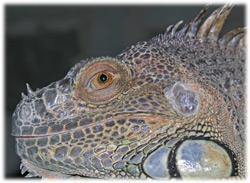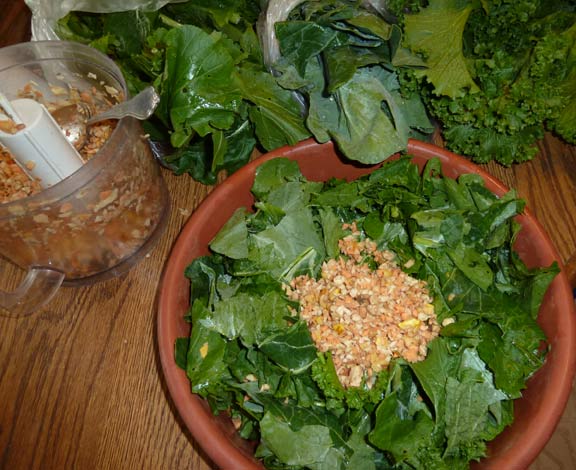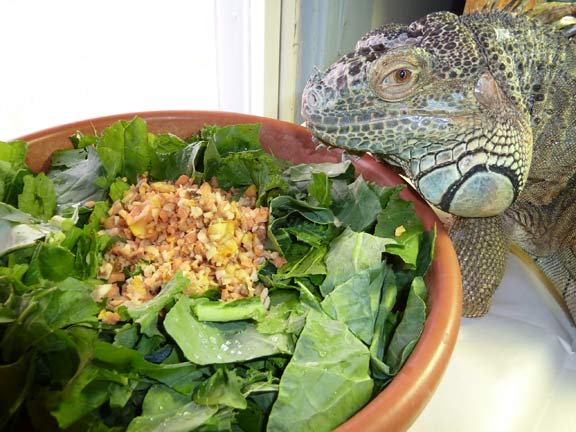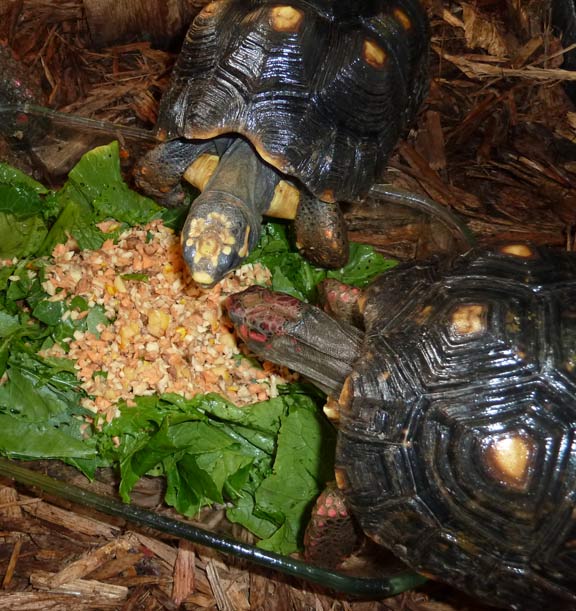

The Green Iguana Diet can seem difficult to get right at first but is not that hard in the long run. Green Iguanas are VEGANS. In the wild they are considered foliovores (leaf-eaters). With this in mind the proper diet consists of lots of leafy greens. While we cannot duplicate their diet in the wild we can try and come close to all the nutrients that they get in the rainforest.
The diet outlined below is a basic guideline for feeding green iguanas based on what I have been feeding my 19 year old green iguana, Pugsley, and several others (including Cyclura) for over 16 years.
Collard greens
Turnip tops
Dandelion greens
Mustard greens
Escarole
Chickory
very occasionally Kale in small amounts
 Wash and dry the leaves, and tear them into small pieces about the size of your iguana's head. If your iguana is so small that he is barely eating a bunch of greens a week, go ahead and break off 2 leaves or so from each bunch in the grocery store. Nowhere does it say you have to buy the whole bunch when it is priced per lb. Stay away from lettuce mixes as they contain mostly non-nutritious greens such as iceberg, redleaf, and greenleaf lettuces, and stay away from the baby greens blends as they contain fewer nutrients than mature greens. In an emergency, you can use romaine, but the recommended greens contain more nutrients in the long run for your rapidly growing iguana. NEVER use iceberg lettuce. It is all water with very little nutritional value. As for the kale; to give you some idea of what I mean by "occasional", I buy one bunch of it about once every 2 months and divy it up amongst 3 large iguanas and 7 tortoises.
Wash and dry the leaves, and tear them into small pieces about the size of your iguana's head. If your iguana is so small that he is barely eating a bunch of greens a week, go ahead and break off 2 leaves or so from each bunch in the grocery store. Nowhere does it say you have to buy the whole bunch when it is priced per lb. Stay away from lettuce mixes as they contain mostly non-nutritious greens such as iceberg, redleaf, and greenleaf lettuces, and stay away from the baby greens blends as they contain fewer nutrients than mature greens. In an emergency, you can use romaine, but the recommended greens contain more nutrients in the long run for your rapidly growing iguana. NEVER use iceberg lettuce. It is all water with very little nutritional value. As for the kale; to give you some idea of what I mean by "occasional", I buy one bunch of it about once every 2 months and divy it up amongst 3 large iguanas and 7 tortoises.
 shredded or chopped raw green beans
shredded or chopped raw green beansshredded peeled raw winter squash (acorn, butternut, pumpkin)
shredded zucchini or yellow squash
shredded parsnip or asparagus
shredded sweet potatos or yams
shredded carrot
green peas
occasionally chopped strawberries, papaya, mango, cantaloupe, blueberries or other fruit (Only add fruit once or twice a week as a treat. Fruit is not on a daily basis)
Mix thoroughly together. For iguanas under one year of age, add a pinch of multivitamin supplement 4-5 times a week, and a pinch of calcium (no D3 added) every day. For healthy older iguanas, reduce the multivitamin to 1-2 times a week, and the calcium to 2-4 times a week.
I vary these ingredients a lot. One day there might be lots of zucchini with some carrots. The next day might be heavy on sweet potato or butternut squash. What does not vary is the mix of greens. My diet is always very heavy on the dark leafy greens.
In addition there are several veggies to avoid. Do not feed them spinach. It contains something that binds calcium and renders it useless. Feed kale only sparingly. I am not a nutritionist and therefore do not know the exact mechanics of WHY we do not feed these items very often. Please refer to www.anapsid.org for details.
 Variety - Variety - Variety - Mix it up and donít get stuck in a rut feeding the same veggie or green all the time. Many of these greens can be bought by the pound so you can vary the amounts of each that you buy.
Variety - Variety - Variety - Mix it up and donít get stuck in a rut feeding the same veggie or green all the time. Many of these greens can be bought by the pound so you can vary the amounts of each that you buy.
Note: This diet is suitable as the basis for other vegan lizards such as Chuckwallas and Uromastyx and tortoises. I also use it for the vegetable portion of my Bearded Dragon's diets.
